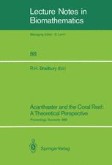Search
Search Results
-
The Use of Morphologic and Molecular Techniques to Estimate Genetic Variability and Relationships of Small Populations
The character of systematic and population studies has been greatly changed by recent advances in techniques of morphologic and molecular analysis....
-
Research on Threatened Populations
The problems posed by threatened populations are stimulating innovative research in a variety of fields. We introduce four areas that have emerged...
-
GAs: Selected Topics
GA theory provides some explanation why, for a given problem formulation, we may obtain convergence to the sought optimal point. Unfortunately,...
-
Game Theory and Population Dynamics in Complex Genetical Systems: The Role of Sex in Short Term and in Long Term Evolution
The article maintains three major points:...
-
Persistent and Transient Populations of the Crown-of-Thorns Starfish, Acanthaster Planci
Current models to explain ‘primary outbreaks’ of Acanthaster planci assume recruitment of larvae to the natal reef. In the light of recent studies...
-
Reviews of Book Contributions
A look at Fred Mosteller’s bibliography reveals that he has had a hand (usually two) in well over fifty books—as author, coauthor, coeditor, or...
-
Evolution and Developmental Programmes
We shall never fully understand the process of evolution until we know how the environment affects the mechanisms that produce pattern and form in...
-
Animal Coat Patterns and Other Practical Applications of Reaction Diffusion Mechanisms
In this chapter we discuss some real biological pattern formation problems and show how the modelling discussed earlier in the book, particularly the...
-
Where Do We Stand on Maximum Entropy? (1978)
In May 1978 a three-day Symposium on ‘The Maximum-Entropy Formalism’ held at M.I.T. provided a good opportunity to put into the record a more...
-
Theories of Euolution of Social Behavior
Two competing theoretical approaches to the evolution of animals’ social behavior, Inclusive Fitness Theory and Fitness Functions Theory, are...
-
A nonlinear measure of subalignment similarity and its significance levels
A new measure of subalignment similarity is introduced. Specifically, similarity s(l,c) is defined as the logarithm to the base p of the probability of...
-
Darwinian Evolution in Ecosystems: A Survey of Some Ideas and Difficulties Together with Some Possible Solutions
Ecology, the biological science of environment, has not produced a synthesis of environment from its broad technical knowledge of influence of...
-
Social Behavior
The study of social behavior encompasses such questions as why social groups form among individuals of a species, why they are of certain sizes and...
-
A mathematical approach to semantic network development
Beginning from the notion of semantic network structure, we develop a quantitative description of how much can be learned by an animal whose...
-
Hierarchical behavior in fit dynamical systems
We consider a class of differentiable dynamical systems that fulfill a criterion of adaptation, or being fit . The adaptation criterion is found to be...
-
Multivariate Analysis and Cranial Diversity in Plio-Pleistocene Hominids
This paper briefly reports on some multivariate aspects of a morphometric study of Plio - Pleistocene hominids. The full study includes univariate...
-
The Profession of Teaching
The 1975 report of the National Advisory Committee on Mathematical Education (NACOME) identified the lack of data regarding teacher education...
-
The stabilizing effect of a random environment
It is shown that the lottery competition model permits coexistence in a stochastic environment, but not in a constant environment. Conditions for...
-
Contractile Function as a Determinant of Muscle Growth
One of the characteristics of a muscle is its ability to adapt to the extent and type of work it is required to perform, both in health and in...
-
Temporal Ongoings in Biology
As was said in Chapter 1, it was formerly ‘read into’ physical science that the universe is passive and inert, and has no initiating powers of its...
